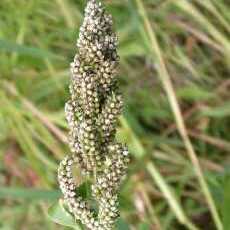Robust, erect, light green annuals. Leaf-sheath light green to pale creamy brown, chartaceous, glabrous, rather loosely enfolding culm, slightly keeled above, finely striate. Ligule 0; ligular area glabrous. Leaf-blade (13)-17-30 cm × 10-16 mm, chartaceous, flat, linear, smooth, or adaxially rarely slightly scabrid on primary lateral ribs, midrib whitish, very distinct; margins whitish, slightly thickened, finely scabrid, tapering to subacute tip. Culm (35)-40-60 cm, stout, internodes glabrous. Panicle 6.5-12 cm, erect, very dense, usually with numerous close-set, sessile, often subverticillate racemes; rachis angular, ridged, scabrid, with a dense ring of bristle-like hairs at base and at nodes. Racemes 1.5-3-(4) cm, of many small dense clusters of spikelets; pedicels finely scabrid, < 1 mm. Spikelets 3-4 mm, purplish, sometimes whitish green, broadly ovate to subglobose, subacute. Glumes quite unequal, firmly membranous, 5-nerved, nerves scabrid, internerves usually finely scabrid-pubescent; lower 1-1.5 mm, enwrapping base of spikelet, upper 2.5-3.5 mm, ≈ spikelet, reflexed at maturity exposing upper part of ripening ☿ floret. Lower floret: lemma similar to upper glume, c. 3 mm, 7-nerved, rotund-ovate, shortly acuminate or shortly cuspidate, nerves scabrid to hispid, internerves minutely scabrid-pubescent; palea < lemma, hyaline, keels minutely scabrid near apex. Upper floret: lemma c. 3 mm, broadly elliptic to rotundate, very convex, crustaceous, obscurely 5-nerved, glabrous, shining, with a minute herbaceous cusp; palea c. 2.5 mm; anthers 0.8-1 mm, yellowish brown to blackish; caryopsis c. 1.5 × 1.5 mm, orbicular, very turgid, yellowish or brownish.
More
Annual. Culms robust, erect, 1–1.5 m tall. Leaf sheaths smooth and glabrous; leaf blades linear, 20–50 × 1.2–2.5 cm, glabrous, margins thickened and wavy. Inflorescence erect, lanceolate, 10–30 cm, axis robust, scabrous along edges and with tubercle-based hairs; racemes 2–6 cm, robust, usually branched, closely spaced and overlapping. Spikelets purplish, tardily deciduous, plump, ovate or obovate-elliptic, 3.5–4 mm, hispid along veins with tubercle-based hairs; lower glume 1/3 as long as spikelet, acute; upper glume slightly shorter than spikelet; lower lemma herbaceous, sterile, acute or with a 0.5–2 cm awn; upper lemma 2.8–3.5 mm. Caryopsis long persistent, eventually falling. Fl. and fr. Aug–Oct. 2n = 54, 56, 72.
An annual grass. It grows 1-1.5 m tall. It forms tussocks. The leaf sheaths are smooth. The leaf blades are 20-50 cm long by 1.2-2.5 cm wide. The edges are thickened and wavy. It is flat and tapers to a point. The inflorescence is an erect panicle 6-20 cm long. The seed heads are purplish. This is probably the cultivated form of Sawa millet (Echinochloa colona).

